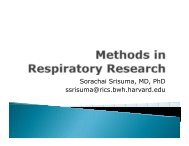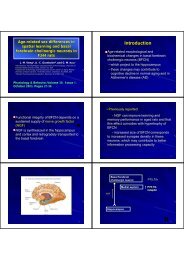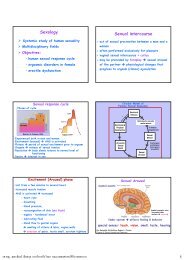Integ50 MedII_KSA3 [Compatibility Mode].pdf
Integ50 MedII_KSA3 [Compatibility Mode].pdf
Integ50 MedII_KSA3 [Compatibility Mode].pdf
- No tags were found...
You also want an ePaper? Increase the reach of your titles
YUMPU automatically turns print PDFs into web optimized ePapers that Google loves.
1. ผลการตรวจ Spirometry<br />
Predicted<br />
Values<br />
Measured<br />
Values<br />
% Predicted<br />
FVC (liters) 6.00 4.00 67<br />
FEV 1 (liters) 5.00 2.00 40<br />
%FEV 1 /FVC<br />
(%)<br />
50<br />
แปลผลได ้ว่า ผู ้ป่ วยรายนี้น่าจะมีความผิดปกติแบบใด?<br />
Obstructive Respiratory Disorder
Normal
Determinants of the Cross-Sectional<br />
Area of the Airway<br />
Normal<br />
• Airway Structure<br />
• Bronchial Smooth Muscle<br />
Tone<br />
• Lung Volume<br />
•Elastic Recoil of the Lung
↓r<br />
R =<br />
8ηl η<br />
πr 4<br />
A<br />
• Increased airway secretion<br />
• Increased mucus secretion
B<br />
↓r<br />
R = 8ηl<br />
πrr 4<br />
Increased airway wall thickness<br />
• Airway smooth muscle<br />
thickness in bronchial asthma<br />
• Airway wall fibrosis in chronic<br />
airway inflammation<br />
• Peribronchial edema from<br />
chronic airway<br />
inflammation/injury<br />
Dampening the effect of<br />
radial traction force
พบได ้ในภาวะถุงลมปอดถูกทําลายหรือ<br />
pulmonary emphysema<br />
ทําให ้ ↑ airway resistance จาก<br />
สาเหตุ<br />
C<br />
– elastic recoil force/pressure<br />
ที่ลดลง<br />
Palv ซึ่งเป็ ซงเปนความดนตนทางของ<br />
นความดันต ้นทางของ<br />
อากาศที่ไหลออกมีค่าลดลง<br />
เกิด dynamic compression of<br />
airway ในส่วน peripheral<br />
airway<br />
– radial traction ti หรอื tethering th force ต่อ airway ลดลง
Flow-Volume Curve in Obstructive Disease<br />
PEF<br />
• The scooped-out out appearance<br />
• Reduced Peak expiratory flow (PEF),<br />
Vmax 50% and Vmax 75%
3. ผลการตรวจ Spirometry<br />
Predicted<br />
Values<br />
Measured<br />
Values<br />
% Predicted<br />
FVC (liters) 5.60 4.40 78.57<br />
FEV 1 (liters) 490 4.90 410 4.10 83.67<br />
%FEV 1 /FVC 93<br />
(%)<br />
แปลผลได ้ว่า ผู ้ป่ วยรายนี้น่าจะมีความผิดปกติแบบใด?<br />
Restrictive Respiratory Disorder
Reduced Compliance<br />
5<br />
L)<br />
Vital ca apacity (<br />
4<br />
3<br />
2<br />
1<br />
Normal<br />
TLC<br />
TLC<br />
Reduced Compliance<br />
Lung collapse (atelectasis)<br />
0 10 20 30 40<br />
Transmural<br />
pressure<br />
(cm H 2 O)<br />
Pulmonary edema<br />
Increase in fibrous tissue in the lung (pulmonary fibrosis)<br />
Obesity<br />
Diseases of chest wall
Key concepts<br />
A systematic way to read the PFTs<br />
…to evaluate it for the presence of<br />
Obstructive disease<br />
Restrictive disease
Step 1. Look at the FVC, to see if it is within normal limits.<br />
Step 2. Look at the FEV1, determine if it is within normal limits.<br />
Step 3. If both FVC and FEV1 are normal,<br />
then you do not have to go any further<br />
…the patient has a normal PFT test<br />
Step 4. If FVC and / or FEV1 are low,<br />
…then the presence of disease is highly likely<br />
Step 5. If Step 4 indicates that there is disease !!!?<br />
then you need to go to the %predicted for FEV1 / FVC<br />
1 If the %predicted for FEV1 / FVC is 90% or higher,<br />
then the patient has a restricted lung disease<br />
2 If the %predicted for FEV1 / FVC is 69% or lower,<br />
then the patient has an obstructed lung disease
วาดกราฟความสัมพันธ์ระหว่าง volume-flow และ<br />
Volume-time ของ forced expiration จนถึง RV<br />
Volume (L)<br />
VC<br />
Flow (L/sec)<br />
time (sec)
ุ<br />
ผู ้ป่ วยหญิง อายุ 32 ปี มาพบแพทย์ด ้วยอาการหมดสติ<br />
แพทย์ให ้การรักษาโดยให ้หายใจผ่านท่อ endotracheal<br />
tube ที่ต่อกับเครื่องช่วยหายใจ ่ กําหนดให ้เครื่องช่วยหายใจ<br />
่<br />
ทํางานเป็ นจังหวะ frequency 12/นาที tidal volume 1000<br />
mL หายใจ O 2 100%, วัดความดัน วดความดน end inspiratory<br />
pressure ใน airway ที่ปลายท่อ 40 cmH 2 O, end-<br />
expiratory pressure 10 cmH 2 O O(ส่วนนี้ (สวนน ผิดไป ผดไป โจทยใหไม โจทย์ให ้ไม่<br />
สมบูรณ์) หลังจากนั้นหนึ่งนาที เก็บอากาศที่ปลายท่อเมื่อ<br />
สิ้นสุดหายใจออกมาวิเคราะห์ได ้ค่า oxygen 97% carbon<br />
dioxide 3% ผลการตรวจ arterial blood ได ้ Pao 2 50<br />
mmHg, Paco 2 40 mmHg pH 7.4 Sao 2 90% ใส่ท่อที่ปลาย<br />
วัดความดันได ั เข ้้ ้าไปในหลอดอาหาร ้ วัดความดันทีสินสุด<br />
ั ั ี่ ิ้<br />
หายใจเข ้า 5 cmH 2 O ความดันที่สิ้นสุดหายใจออก 0 cmH 2 O
Endotracheal tube
1. PAo 2 เมื่อพิจารณาค่า Pao 2 การแลกเปลี่ยนแก๊สเป็ นเช่นไร<br />
2 2<br />
คิดว่าน่าจะเกิดความผิดปกติอะไรบ ้าง<br />
PAO 2 = FIO 2 (Patm –PH 2 O) –<br />
= PIO 2 – PACO 2<br />
R<br />
PACO 2<br />
R<br />
สูตรจาก p.482<br />
= 1.0 (760-47) – 40/0.8<br />
= 713 – 50<br />
= 663 mmHg
1. PAo 2 เมื่อพิจารณาค่า Pao 2 การแลกเปลี่ยนแก๊สเป็ นเช่นไร<br />
2 2<br />
คิดว่าน่าจะเกิดความผิดปกติอะไรบ ้าง<br />
PAO 2 = 663 mmHg<br />
Pao 2 = 50 mmHg<br />
Paco 2 = 40 mmHg, pH 7.4<br />
มี hypoxemia, ระดับ CO 2 tension และ pH ปกติ<br />
ี l l t i l diff ิ ไ ้<br />
ม alveolar-arterial oxygen difference เกดไดจาก<br />
-Diffusion impairment<br />
-Shunt<br />
-Ventilation-perfusion mismatch
2. CO 2 production (Vco 2 2)<br />
Vco 2 = VT x FEco 2<br />
สูตรจาก p.479 ข ้างล่าง<br />
= VT x frequency x FEco 2<br />
= 1000 mL x 12/min x 0.03<br />
= 360 mL/min<br />
= 0.36 L/min<br />
ถ ้าพิจารณาจากสูตร p.479 - 480 ค่า FIco 2 = 0,<br />
ดังนันจึงไม่คิดปริมาณ ้<br />
CO 2 จาก dead space
3. Alveolar ventilation (VA)<br />
Vco 2 = VA x FAco 2<br />
สูตรจาก p.479 ข ้างบน<br />
FAco 2 = PAco 2 / (PB –47) สูตรจาก p.484<br />
= Paco 2 / (PB – 47)<br />
= 40 mmHg / (760 – 47)mmHg<br />
= 0.056 or 5.6%<br />
ถ ้าพิจารณาจากสูตร p.479 - 480 ค่า FIco 2 = 0,<br />
ดังนั้นจึงไม่คิดปริมาณ ดงนนจงไมคดปรมาณ CO 2 จาก dead space
3. Alveolar ventilation (VA)<br />
Vco 2 = VA x FAco 2<br />
FAco 2 = 0.056 or 5.6%<br />
Vco 2 = 0.36 L/min<br />
VA = 0.36 L/min / 0.056<br />
= 6.42 L/min
4. Dead space ventilation (VD)<br />
VT = VA + VD<br />
VD = VT<br />
- VA<br />
VD = 12 L/min - 6.42 L/min<br />
= 5.58 L/min
5. Dead space volume (VD) ต่อการหายใจหนึ่งครั้ง ค่าที่ได ้ปกติหรือไม่<br />
VD = VD / frequency<br />
VD = 5.58 L/min<br />
VD = 5.5858 L/min<br />
12 breaths/min<br />
VD = 0.465 L or 465 mL, exceeding normal value<br />
The normal value of VD V = is 150 mL.<br />
มี alveolar-arterial oxygen difference เกิดได ้จาก<br />
-Diffusion impairment<br />
-Shunt<br />
-Ventilation-perfusion mismatch (dead space like ventilation)
5. Dead space volume (VD) ต่อการหายใจหนึ่งครั้ง ค่าที่ได ้ปกติหรือไม่<br />
VD =PAco 2 – PEco 2 หรือคํานวณอีกวิธีหนึ่งด หรอคานวณอกวธหนงดวย ้วย<br />
VT PAco 2<br />
สูตรจาก p.480 ข ้างบน<br />
PEco 2 =FEco 2 x (PB – 47)<br />
= 0.03 x (760 – 47)<br />
PEco 2 = 21.39 mmHg<br />
VD = (40-21.39) x 1000 mL<br />
40<br />
VD = 0.465 L or 465 mL, exceeding normal value<br />
The normal value of VD = is 150 mL.<br />
มี alveolar-arterial oxygen difference เกิดได ้จาก<br />
-Diffusion impairment<br />
-Shunt<br />
-Ventilation-perfusion mismatch (dead space like ventilation)
Pressure-Volume Curve of the chest wall, lung,<br />
respiratory system<br />
100<br />
TLC<br />
% total lu ung capa acity<br />
80<br />
60<br />
40<br />
20<br />
Chest<br />
wall<br />
FRC<br />
lung<br />
Lung +<br />
chest wall<br />
-40<br />
-30<br />
-20<br />
-10<br />
0 10 20 30 40<br />
Transmural pressure (cm H 2 O)<br />
Transmural pressure (PTM) of lung is Palv – Ppl<br />
PTM of chest wall is Ppl – Pbs (body surface pressure or PB) = Ppl<br />
PTM of total respiratory system = PTM of lung + PTM of chest wall<br />
= Palv – PB = Palv
6. Total respiratory system compliance (CRS)( ) ค่าที่ได ้ปกติหรือไม่<br />
PTM of total respiratory system ที่ปริมาตรค่าหนึ่ง (ดูจากกราฟ)<br />
= PTM of lung + PTM of chest wall<br />
= Palv – PB<br />
At the end of inspiration or expiration, there is no flow and pressure<br />
gradient. So Paw = Palv at the end of inspiration or expiration.<br />
CRS = ΔV/ ΔP (distending pressure) ช่วงหายใจเข ้า-ออก<br />
= 1000 mL / (40-10) cmH 2 O<br />
CRS = 33.3 mL/cmH 2 O or 0.033 L/cmH 2 O<br />
This is reduced from a normal value of 100 mL/cmH 2 O<br />
p. 497
7. lung compliance (CL) ค่าที่ได ้ปกติหรือไม่<br />
CL = ΔV/ / ΔP (distending gp pressure) ช่วงหายใจเข ้า-ออก<br />
ΔP = (40-5) – (10-0) = 25 cm H2O<br />
CL = 1000 mL / 25 cmH 2 O<br />
CL = 40 mL/cmH 2 O<br />
This is reduced from a normal value of 200 mL/cmH 2 O 2<br />
p. 497
8. Chest wall compliance (CCW)( ) หรือคํานวณอีกวิธีหนึ่งด ้วย<br />
สูตรจาก p.497 ข ้างบน<br />
CCW = ΔV/ / ΔP (distending gp pressure)<br />
ΔP = 5 – 0 = 5 cm H2O<br />
CCW = 1000 mL / 5 cmH 2 O<br />
CCW = 200 mL/cmH 2 O<br />
This is the normal value of 200 mL/cmH 2 O 2<br />
p. 497
คนไข ้มี hypoxemia, normocapnia (reflex hyperventilation)<br />
มี dead space เพิ่มขึ้น<br />
มี lung compliance ลดลง แต่ค่า chest wall compliance ปกติ<br />
มี alveolar-arterial oxygen difference (663 vs 50 mmHg)<br />
เกิดได ้จาก<br />
-Diffusion impairment<br />
-Shunt (e.g. lung collapse, pulmonary edema)<br />
-Ventilation-perfusion mismatch (e.g. positive end<br />
-expiratory pressure compresses alveolar capillaries<br />
สัมพันธ์กับ dead space like ventilation)
Dead Space
Pulmonary Vasculature<br />
If Palv > Pcapillary (Pc)<br />
Cessation of flow<br />
If Pa > Palv > Pv, the vessel will<br />
alternate between flow and closure<br />
(Starling resistor)


![Integ50 MedII_KSA3 [Compatibility Mode].pdf](https://img.yumpu.com/53541610/1/500x640/integ50-medii-ksa3-compatibility-modepdf.jpg)







